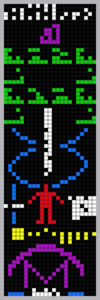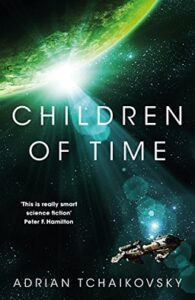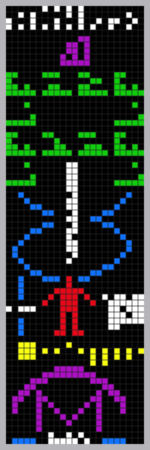My morning scan of internet news sources—reputable, disreputable, licit, and illicit—unearthed the tantalizing headline, “The true story of the fake unboxed aliens is wilder than actual aliens.” I just had to read the story, which was on Vox, and it was about an exhibit presented to the Mexican congressional committee investigating UFOs (who knew they had such a thing?), that contained “dog-sized” mummies of purported aliens that were actually glued together parts of real human mummies and a partial skull of a llama. I have to admit that I read the story, mostly because I like to read about fake news and conspiracy theories being debunked and—bias disclaimer—I regard all stories about UFOs and aliens visiting earth as fake, or at least mistaken. So why am I still intrigued by aliens and, particularly, alien minds?
One of my main interests is the human mind. I’m a psychologist, I’ve done research on the brain and how we learn, and I have an intense interest in artificial intelligence, which not only is fascinating in its own right, but is helping us learn more about our own minds. I think there’s a 50:50 chance that we’re not the only intelligent creatures in the universe (and a 99:1 chance that we soon won’t be the only human-level intelligences on earth because of AI). But AI intelligence, at least in the models that are now being pursued, which are based on artificial neural networks trained on data produced by humans, such as speech or movements, will, in the short term anyway, probably resemble our own intelligence. Our brains and our intelligence and our minds were shaped by our adaptation to the conditions on earth and represent not just that adaptation, but a lot of chance mutations that took our evolutionary development in one direction rather than another. With aliens from another planet, everything would be different.
Science only hints at what conditions on the surface of other planets might be like. After all, it was only in 1992, a little over 30 years ago, that the first exoplanet orbiting another star was confirmed by the Arecibo Observatory in Puerto Rico. For most of the known exoplanets, we are still finding out if they are gaseous or rocky, likely to have an atmosphere or water, and even how fast they rotate. The question of whether they could sustain life is up in the air (no pun intended) and is also limited by our own ignorance of what forms life might take and what chemical and molecular combinations are necessary for it to exist in other environments. The question of what an alien’s mind might be like is purely speculative and hampered by our own inability to think beyond the model provided by our own minds. That’s where science fiction writers come in.
At least half of the science fiction that features aliens has them being humans, but from other planets. At least half, and perhaps as much as 90% of the science fiction that features non-human aliens portrays them as thinking like humans, even if their tentacled, or massive, or appendageless, or multi-headed bodies are vastly different. After all, the writer who chooses to include an alien who thinks in a manner foreign to how humans think has the daunting task of trying to convey such thinking to their readers, who, of course, only think like humans.
Stanislaw Lem is a philosopher and science fiction writer who has tackled this problem. In his novel, The Invincible, the aliens are tiny automata, descended from small robotic assistants to members of an alien race, which crash-landed on a planet. Over eons, the automata evolved into a collection of tiny “flies,” which, although not individually conscious or possessed of reasoning, use evolved herd behaviors to destroy their alien masters and all other living creatures on the planet’s surface, including the humans who come to visit.
The idea of a herd mind, as it is often called, is not unique to Lem, and, in fact, is one way of describing how ants, bees, and termites manage complex cooperative behaviors to build their nests. Starling “murmurations,” as the beautiful, ever-changing patterns of hundreds of the birds in flight are called, or the “schooling” behavior of fish, are less complex, but nevertheless finely coordinated examples of such group behavior. Because it happens with across several non-human species here on earth, it is a candidate for a possible behavior of creatures from another planet, even if, in Lem’s case in The Invincible, the creatures are not organic.
In another Lem novel, Solaris, humans discover a planet with only a single creature on it—a massive, alive, ocean, which obeys higher-order mathematical principles and has an ability to create copies of the humans’ most intimate memories. Its purpose, if it has one, and its way of thinking are incomprehensible to humans, including the main character, who learns that there are ways of being that are simply beyond the comprehension of humans because the concepts by which we think and perceive provide a limit to our understanding.
Without understanding how aliens think, it seems logical to many people that, if they are intelligent, they probably understand some mathematics, and in fact, mathematics may be the only thing we have in common. But of course, they wouldn’t use our number system, and probably not even use a base of ten. The scientists behind the SETI project have wrestled with similar issues in devising a message to beam into space. They opted for using binary code in a bitmap for their message. Unfortunately, at least the first message was not as clear as its developer, Frank Drake, had hoped, because when he sent a prototype of the message to his colleagues, including some Nobel Prize winners, none of them could figure what it meant.

Arecibo Message 1974
Stanislaw Lem partially solved the problem of describing alien minds by focusing on the behaviors such minds produced, without taking the step of entering the interiors of those minds to examine their thoughts. This left the reader, as well as the human characters in the novels, with the task of trying to figure out, using human concepts, how those creatures were thinking. In his novels, the humans were unsuccessful.
Julie E. Czerneda’s 2022 novel, To Each This World, is wildly original, especially in its depiction of aliens. Central to its plot are the Kmet, who are gigantic, sloppy, imperious characters whose mode of thought, communication and motivation are obscure (they use an intermediary for communication). There is also the Divider, which may be the greatest force to fear, or benign.  Figuring out what the alien species’ intentions are is the main plot of the novel and it’s a delightful and thought-provoking plot to follow.
Figuring out what the alien species’ intentions are is the main plot of the novel and it’s a delightful and thought-provoking plot to follow.
Adrian Tchaikovsky is not afraid to play with ideas and turn some scientific concepts on their heads. In Children of Time, genetic inheritance is not just Darwinian, but Lamarckian: experiences and learning are passed from one generation to another. The race that is marching toward the stars as a result of profiting from this newfound inheritability of knowledge, is not even human, it is arachnoid—spiders. And the spider brain and society are, true to form, “spider-like” as they develop, even to the point of creating organic computers made from chemically guided groups of ants mindlessly carrying out simple functions as part of a larger, organized, intelligent whole.
In Children of Ruin, Tchaikovsky keeps the spiders, who have now partnered with the humans to go exploring, and together they meet the progeny of a terraforming project, which the author reveals to us in a parallel story, and in which genetically modified octopuses are dumped into an oceanic planet’s waters to begin the transformation of the planet but have themselves changed by the time the spiders and humans arrive. Someone, I can’t remember who, has said that octopuses are as close to alien minds as we’re going to get here on earth. Their brains are distributed throughout their 8-tentacled bodies, and they live solitary lives (though not always) except for when they mate, and then they die. They can solve all sorts of puzzles, suggesting considerable intelligence, but their social and emotional life is a mystery. Tchaikovsky has taken poetic liberties with the known facts and delved into the mysteries of octopus’s feelings and motivation, though not enough for us to really understand them. And if spiders and octopuses aren’t enough, there are some kind of plant/animal creatures that are true aliens (not originally from earth) whose minds are a total mystery. While the author’s venture into understanding other minds is mostly imaginative, it is instructive in making us think how different our minds are from those of creatures with whom we share out planet.
The novels mentioned above are just a sample of those that deal with alien minds (Adrian Tchaikovsky has a lot more examples in other series, such as in his The Final Architecture series, where asteroid-sized beings with incomprehensible motives turn entire planets inside out). Authors seem to follow two models in developing characters with such minds: to be not like us and to resemble non-human species from earth. Beyond that, the only parameters defining such creations are the limits of the authors’ imaginations and the comprehension of readers. Whatever our science fiction writers come up with are bound to be wrong, although patterns of thinking and behavior that are not confined to a single species or environment on earth may be slightly more probable than those found in only humans, and, depending upon the extent that our chemistry, math and physics are based on some kind of universals, then representing such constants is probably an adaptive characteristic of even alien minds, giving us a medium of communication if we can figure out how to translate from our concepts of such things to theirs. It’s a fertile field for our most imaginative writers and one that I love to explore, as I think many science fiction fans do.
Can an AI really be conscious? Would that make it more or less dangerous? Read Casey Dorman’s exciting sci-fi thriller, Ezekiel’s Brain.
Available in paperback and Kindle editions
Rather listen than read? Download the audio version of Ezekiel’s Brain from Audible.
Subscribe to Casey Dorman’s Newsletter. Click HERE







Thanks for the mini-reviews and author intros. Except for Ezekiel’s Brain I haven’t read any Sci-fi for a long time. I might try some of these. Thanks for your musings on alien minds, too. Thought provoking…